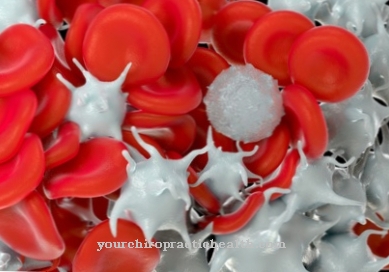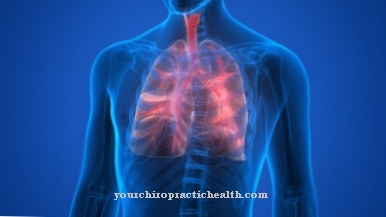Of the Sense of balance is used for orientation in three-dimensional space, the determination of the body position in space including the limbs and the coordination of complex movement sequences.
The sense of balance feeds itself primarily from direct feedback from the paired vestibular organs in the inner ear, and feedback from thousands of proprioceptors in muscles, tendons and ligaments influence the sense of balance. Visual feedback also has a strong influence and can even "overrule" vestibular stimuli at short notice.
What is the sense of balance?

Strictly speaking, the sense of balance includes a complex, composite sensory perception that is based not only on the feedback from a single sensory or sensor organ, but on the sensor messages of the vestibular organs connected by the brain, the numerous proprioceptors and the eyes, which are present in all muscles, ligaments and tendons. Hearing impressions and the skin's sense of touch can also play a role and make a contribution.
Primarily, however, the paired vestibular or equilibrium organs in the inner ear should be mentioned. They are made up of three semicircular canals that are perpendicular to one another and two otolith organs each. The vestibular organs are sensitive to rotational and linear accelerations, which they convert into nerve impulses and convey via the vestibular nerve to the brain, which processes the messages along with other inputs.
Each semicircular canal is specialized in one of the three possible rotational accelerations around the vertical, transverse or longitudinal axis, while only the two otolith organs sacculus and utriculus are available for the three possible linear acceleration directions forwards / backwards, sideways to the left / right and up / downwards .
The force of gravity corresponds to a linear acceleration that is always directed towards the center of the earth and plays an important role in body alignment.
Function & task
In evolutionary terms, the sense of balance has the task of enabling and facilitating complex movement processes such as walking upright, jumping, running and dangling in branches as well as balancing, if necessary also in the dark, i.e. completely without seeing.
The complex movement sequences are for the most part not innate, but are acquired through practice. A toddler, for example, needs a long time to master upright walking safely. Achieving this through learning has the advantage that other complex movement patterns such as riding two-wheelers or even unicycling, driving a car and steering a plane can be learned.
The learned movement patterns are stored in the multi-sensory movement memory and can then be called up as required and even carried out unconsciously - almost automatically. After a certain amount of practice, people no longer have to concentrate on cycling, but can chat and relax on the side.
While walking upright in total darkness or with your eyes closed is possible, there is no longer good control over the direction in which we walk. Usually a few seconds are enough for a deviation from the straight line to be observed. The deviation usually results from the fact that we are slowly turning in circles.
Vestibular feedback has the great advantage that it is very fast, significantly faster than visual impressions via the central visual field and is therefore very well suited as inputs for the coordination and control of complex movement sequences.
However, they have the major disadvantage that they briefly emit false impulses after being subjected to stronger acceleration or deceleration because the endolymph in the semicircular canals or in the otolith organs is still in motion due to inertia.
This is the effect that figure skaters or dancers experience after suddenly stopping a pirouette. The brief disorientation with a lagging sensation of rotation can be corrected by fixing the environment within fractions of a second, because the brain uses the visual impression to suppress the “wrong” angular momentum of the vestibular sense.
Conversely, the brain can e.g. B. also set missing vestibular stimuli if the eye shows a situation in which an acceleration should take place, but none is available. Experienced pilots can therefore definitely feel an acceleration in a flight simulator with a good vision system without movement when accelerating to take off (vection illusion).
You can find your medication here
➔ Medicines for balance disorders and dizzinessIllnesses & ailments
The most common problem with the sense of balance is kinetosis, also known as travel, sea or simulator sickness, which is only a temporary phenomenon and manifests itself in a mild form as malaise or in more severe forms as severe nausea and vomiting.
The kinetosis is very likely due to sensor conflicts between the individual sensors, i.e. between vision, vestibular impressions and proprioceptive messages. This also means that, for example, the eyes signal certain situations that are normally coupled with vestibular stimuli, but which do not occur at all, as in a motionless driving or flight simulator. This can certainly happen to an experienced visual pilot with no simulator experience when flying in a motionless simulator.
Diseases of the vestibular organs are usually paired with vertigo and nausea, which can lead to vomiting. The most common form of vestibular rotational vertigo is benign paroxysmal positional vertigo, which can be triggered, for example, by Menière's disease. It is an increased accumulation of fluid in the membranous labyrinth, the seat of the vestibular organs.
Continuous vertigo with nausea can be triggered by vestibular neuritis, an inflammation of the vestibular nerve. Often the symptoms are accompanied by nystagmus, an involuntary eye movement in a kind of jagged pattern that normally occurs when the patient is spinning continuously (e.g. pirouette).
Overall, the reasons for the occurrence of dizziness and other balance disorders are very diverse. In many cases, cardiovascular diseases such as high blood pressure (hypertension) and low blood pressure (hypotension) already trigger disturbances in the sense of balance.









.jpg)



.jpg)



.jpg)







.jpg)


